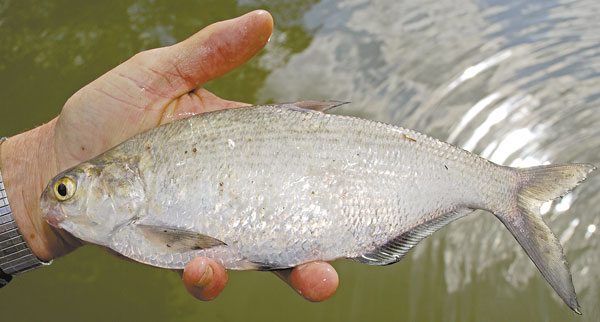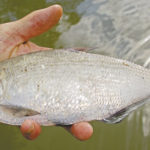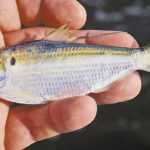
The herring family is a big one. Called Clupeidae by biologists, it holds 28 members in North America. Fourteen are found in Atlantic Ocean waters, including the Gulf of Mexico, five in Pacific waters, one in both the Atlantic and the Pacific, six migrate between freshwater and Atlantic ocean waters, and only two, the gizzard shad and the threadfin shad, are freshwater species. Both are common in Louisiana.
There is not a lot that comes out of the water that I don’t eat, but shad is one of them. They make better bait than table fare. Because of the algae that these freshwater fish eat, they smell like fermented grass. They are also very oily. A few of them left in a bucket all day will leak a surprising amount of oil out of their bodies.
And to add possible injury to insult, all herrings, including our shad, are full of tiny bones. Like almost all other fish, they have a ribbed skeleton that extends off their backbones. But in addition, they have very tiny, sharp, almost-invisible intramuscular bones in their flesh. They are arranged in two longitudinal rows, but to a diner, they appear to be everywhere in the flesh. The herringbone fabric pattern in sports coats is named after the arrangement of these bones in the fishes’ flesh.
A few things can be done to make the bones less offensive. Pickling with an acidic liquid will soften the bones to where they are unnoticeable, and so will canning with high heat and moisture. Those sum up the two ways that I eat members of this boney clan — pickled herring and canned sardines.
But shad play an important role in freshwater ecosystems, and by extension, are important to fishermen. Both gizzard shad (Dorosoma cepedianum) and threadfin shad (Dorosoma petenense) are grazers, eating plankton, the grass of the lakes and rivers. In turn, they serve as a food source for predaceous fishes.
The two species are similar. Both are nondescript silver fish with no outstanding features other than having the last few rays in the dorsal fin elongated into a whip-like streamer. Both are strongly laterally compressed, a biologist’s term for fish that are flattened side-to-side.
There are some differences though. The major one is where the mouth is located on the head. In gizzard shad, it is distinctly underslung, with the lower jaw being shorter than the upper jaw. In threadfin shad, the lower jaw protrudes lightly beyond the upper jaw.
Threadfin shad also have a distinct yellow tint in their fins, especially the tail fin. Threadfin shad and juvenile gizzard shad have a noticeable black spot on the shoulder behind their gill cover. Any shad that doesn’t have the spot is a mature gizzard shad.
Besides filtering plankton from the water with long projections from their gill arches called gill rakers, both shad, especially gizzard shad, will graze on water bottoms eating plant and animal debris, sand and mud. All of this goes into a muscular gizzard that grinds what is eaten for digestion.
Both species spawn in the spring when water temperatures reach the 60s beginning in April. Spawning is done in groups, near the surface of the water. The roiling school of fish broadcasts their eggs and sperm into the water for random fertilization. After the eggs are fertilized, they will sink to the bottom to stick to gravel, plants, tree branches or any other firm surface.
Threadfin shad seldom grow larger than 6 inches long, compared to the 16 inches that an adult gizzard shad will reach. Because of their small size and abundance, threadfin shad are an important forage fish for predatory species such as largemouth bass.
Bass so love to feed on threadfin shad that they will track the movement of their schools from shallow water to deep water in the morning and then back again in the evening. Threadfin shad are very surface-oriented fish.
Because of their value as a bait species, threadfin shad have been stocked in many impoundments beyond their original range in the eastern United States. Their major drawback is that they are very susceptible to cold weather, and large die-offs occur at water temperatures lower than about 40 degrees.
Gizzard shad have much less value as food for game fish because they rapidly grow too large for anything but alligator gar, large catfish and striped bass to eat. In some lakes, populations of large gizzard shad have become so large that they compete with juvenile game fish for food. Much of the justification for stocking striped bass in such water bodies is for control of gizzard shad numbers.
Both commercial and recreational fishermen do use gizzard shad for bait. It is one of the very best baits for use in crawfish traps. When other baits become hard to get, catfish trotliners will also often use gizzard shad as cut bait.
Where gizzard shad really shine as a baitfish is in the trophy fisheries for large blue catfish that has developed in the south Atlantic states. There, it is the bait of choice.




